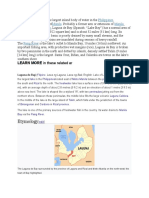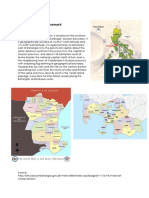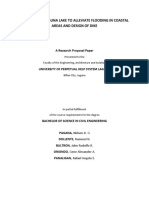Laguna State Polytechnic University Main-Campus Sta. Cruz, Laguna
Laguna State Polytechnic University Main-Campus Sta. Cruz, Laguna
Uploaded by
bhabymavz_23Copyright:
Available Formats
Laguna State Polytechnic University Main-Campus Sta. Cruz, Laguna
Laguna State Polytechnic University Main-Campus Sta. Cruz, Laguna
Uploaded by
bhabymavz_23Original Description:
Original Title
Copyright
Available Formats
Share this document
Did you find this document useful?
Is this content inappropriate?
Copyright:
Available Formats
Laguna State Polytechnic University Main-Campus Sta. Cruz, Laguna
Laguna State Polytechnic University Main-Campus Sta. Cruz, Laguna
Uploaded by
bhabymavz_23Copyright:
Available Formats
LAGUNA STATE POLYTECHNIC UNIVERSITY MAIN-CAMPUS STA.
CRUZ, LAGUNA
Bodies of Water in the Philippines MAJOR 13 ECOLOGY
Ms. Marivic F. Dublin BEED III-A
Mrs. Laarni Bundalian. January 10, 2012.
Enclosed Water Bodies
Lakes occupy 1,830 square kilometers (0.61 percent of total area). There is no updated inventory of the lakes at present, but a recent study has placed the number of lakes at 72. The largest lake is the Laguna de Bay, which encompasses two regions: Metro Manila and Region IV with an area of 922 km. Lake Taal 56km south of Manila, occupies a huge volcanic crater and contains an island that is itself a volcano, with its own crater lake. Lake Lanao the largest lake in Mindanao, which is a major source of hydropower.
Source: Philippine Environment Monitor 2003
Laguna Lake Laguna de Bay is one of the largest lakes in Southeast Asia and the largest and one of the most vital inland bodies of water in the Philippines. Pre-Hispanic Filipinos called the lake, Lawa ng Bai (pronounced as ba-ee), meaning Mother Lake. With Spanish colonization, the name became Laguna de Bay or Lake of Bay.
It spans some 90,000 hectares, with around 100 rivers and streams draining into it. It is cradled by a watershed area of 292,000 hectares encompassing the whole of 2 provinces and parts of Metro Manila, Batangas, Cavite and Quezon all in all, 12 cities and 49 municipalities. This area spans 2,656 barangays, 187 of which are within lakeshore towns. It is bound by the province of Rizal to the North. It is the heart of CALABARZON (Cavite-Laguna-BatangasRizal-Quezon), one of the fastest growing economic zones in the country today. It answers to the competing and, often times, conflicting needs and demands of a watershed population of some 6 million (NSO 2000). It is host to some 10,000 small-, medium- and large-scale enterprises. In August 2001, Laguna de Bay was unanimously accepted as the 18th member of the International Living Lakes Network. Laguna de Bay is estimate to receive approximately 74,300 tons per year of BOD pollution. Domestic sources contribute 69 percent while the remaining 31 percent is from industrial and agricultural sources. Additionally, with the sedimentation rate of 0.5 centimeters per year, an estimated 66 percent of the land area in the watershed is vulnerable to erosion.
Routine monitoring of BOD in Laguna Lake shows that is meets the Class C water quality criterion (Figure 10). This indicates that BOD is not an issue, but siltation may be the main problem.
You might also like
- Pasig RiverDocument34 pagesPasig RiverNhilo ReginoNo ratings yet
- 15 Laguna de Bay 27february2006Document34 pages15 Laguna de Bay 27february2006Katrina OblefiasNo ratings yet
- Water Quality Analysis and Evaluation of Management Strategies and Policies in Laguna Lake, PhilippinesDocument11 pagesWater Quality Analysis and Evaluation of Management Strategies and Policies in Laguna Lake, PhilippinesAaron Marius JuliusNo ratings yet
- Ce 429 Lecture 3 Water Resources RegionsDocument46 pagesCe 429 Lecture 3 Water Resources RegionsJhess Nazer Jaime AsisNo ratings yet
- Water Resources in PhilippinesDocument11 pagesWater Resources in PhilippinesChristine RiveraNo ratings yet
- 6 NamokaDocument34 pages6 NamokaNicolas James BolinaNo ratings yet
- The Water Quality of The Pasig River in The City of Manila, Philippines - Current Status, Management and Future Recovery PDFDocument7 pagesThe Water Quality of The Pasig River in The City of Manila, Philippines - Current Status, Management and Future Recovery PDFDeni Mendoza100% (1)
- Water Resources in The PhilippinesDocument3 pagesWater Resources in The PhilippinesAllan DeGuzman Dela VegaNo ratings yet
- CAPULE A Case Study of Water Pollution On Laguna de BayDocument24 pagesCAPULE A Case Study of Water Pollution On Laguna de Baykelvin100% (1)
- Laguna de BayDocument11 pagesLaguna de BayIrish Bianca Usob LunaNo ratings yet
- Tullahan RiverDocument4 pagesTullahan RiverDANICANo ratings yet
- Industrial Wastes of Libmanan River and Its Effects To The Quality of The River and Its Life FormsDocument25 pagesIndustrial Wastes of Libmanan River and Its Effects To The Quality of The River and Its Life FormsAlaii CuyaNo ratings yet
- Geophysical and ETCDocument12 pagesGeophysical and ETCEmileeh JensenNo ratings yet
- The Water Quality of The Pasig River in The City o PDFDocument8 pagesThe Water Quality of The Pasig River in The City o PDFMikhail Roy Dela CruzNo ratings yet
- Water Quality of Pasig RiverDocument8 pagesWater Quality of Pasig RiverManna PintoNo ratings yet
- ENS 203-State of Freshwater Ecosystems-NatividadDocument14 pagesENS 203-State of Freshwater Ecosystems-NatividadRaysolyn NatividadNo ratings yet
- Assignment No.2 Sa Hydro Ni BryDocument4 pagesAssignment No.2 Sa Hydro Ni BryMAP BNSNo ratings yet
- Water AssignmentDocument8 pagesWater AssignmentAllysa Nicole DavidNo ratings yet
- ENS 203-State of Freshwater Ecosystems-V2Document14 pagesENS 203-State of Freshwater Ecosystems-V2Raysolyn NatividadNo ratings yet
- Environment PDFDocument35 pagesEnvironment PDF葉約翰No ratings yet
- Chapter 10Document35 pagesChapter 10stephanier_24No ratings yet
- Assignment On A Virtual Water TaxiDocument7 pagesAssignment On A Virtual Water TaxiphylesngumbiNo ratings yet
- Raduban, Bea Therese S. ME165-4/A39 Assignment # 1 Home Province: LAGUNA DescriptionDocument4 pagesRaduban, Bea Therese S. ME165-4/A39 Assignment # 1 Home Province: LAGUNA DescriptionBea Therese RadubanNo ratings yet
- PH Water Resource RegionsDocument52 pagesPH Water Resource RegionsErickson CauyaoNo ratings yet
- Overview of Manila Bay (2017)Document11 pagesOverview of Manila Bay (2017)Moira YapNo ratings yet
- 028Document11 pages028Chrisneil DelosreyesNo ratings yet
- Flood Disaster Mitigation and River Rehabilitation by Marikina City, PhilippinesDocument8 pagesFlood Disaster Mitigation and River Rehabilitation by Marikina City, Philippinesajachurail100% (1)
- 2017 Plenary Paper Lasco RD 2Document4 pages2017 Plenary Paper Lasco RD 2Frianne FrondarinaNo ratings yet
- Module 06Document38 pagesModule 06John Keith MaderaNo ratings yet
- Lake Lanao Policy StudyDocument30 pagesLake Lanao Policy StudyGodfrey MordenoNo ratings yet
- Region 2 Cagayan Valley AnalysisDocument2 pagesRegion 2 Cagayan Valley AnalysisJohn Mark BalaneNo ratings yet
- Libmanan P Watershed ArticleDocument12 pagesLibmanan P Watershed ArticleJeremy RolaNo ratings yet
- Calibato LakeDocument13 pagesCalibato LakeAlfalfa LanuzaNo ratings yet
- Group 2 Case Analysis Pre Final TPDocument5 pagesGroup 2 Case Analysis Pre Final TPRenalyn Balinas100% (1)
- 2021 LDBR As Water Quality Mngt. Area (Ms. Marian Soriano)Document29 pages2021 LDBR As Water Quality Mngt. Area (Ms. Marian Soriano)remer jalbunaNo ratings yet
- Magdalena Fishes 2007Document15 pagesMagdalena Fishes 2007ivan lopezNo ratings yet
- Dredging of Laguna Lake To Alleviate Flooding in Coastal Areas and Design of DikeDocument3 pagesDredging of Laguna Lake To Alleviate Flooding in Coastal Areas and Design of DikeJohn Rodolfo BultronNo ratings yet
- 45 04eDocument13 pages45 04eMaria Kathreena Andrea AdevaNo ratings yet
- 45 04e PDFDocument13 pages45 04e PDFIvy Grace BarteNo ratings yet
- Province Profile - Provincial Government of LagunaDocument5 pagesProvince Profile - Provincial Government of Laguna1 month old FujoshiNo ratings yet
- History of Cagayan River: Presented By: Shaidelle LuisDocument10 pagesHistory of Cagayan River: Presented By: Shaidelle LuisMars Maguen100% (1)
- Laguna de Bay - A Vision For The FutureDocument5 pagesLaguna de Bay - A Vision For The FuturesinosikpNo ratings yet
- 4-Flood Mitigation Philipines ADPC PDFDocument8 pages4-Flood Mitigation Philipines ADPC PDFBelle Estal PalajosNo ratings yet
- Laguna Lake Development AuthorityDocument1 pageLaguna Lake Development AuthorityEthan ZacharyNo ratings yet
- Laguna Lake Development AuthorityDocument1 pageLaguna Lake Development AuthorityEthan ZacharyNo ratings yet
- SmprucDocument8 pagesSmprucAndrea SantosNo ratings yet
- Dams in The CordilleraDocument9 pagesDams in The Cordillerapaolojaspiras7939No ratings yet
- WRM - Full Manuscript Requirement Example 7.07.23 AMDocument31 pagesWRM - Full Manuscript Requirement Example 7.07.23 AMRaneniel LomibaoNo ratings yet
- Gulf NewsDocument14 pagesGulf NewsAve RyNo ratings yet
- Sablayan Water District Development PlanDocument27 pagesSablayan Water District Development PlanMichael Umpad Quinatadcan100% (1)
- Water Pollution EAPPDocument4 pagesWater Pollution EAPPHiyesa Anne Gonzales MarcosNo ratings yet
- 2009 Typhoon Ondoy Flood Disasters in Metro Manila: Teruko SATO and Tadashi NAKASUDocument12 pages2009 Typhoon Ondoy Flood Disasters in Metro Manila: Teruko SATO and Tadashi NAKASUAngel RondillaNo ratings yet
- Lake VictoriaDocument2 pagesLake VictoriaPRANAVNo ratings yet
- Laguna de Bay 2013 Ecosystem Health Report Card PDFDocument8 pagesLaguna de Bay 2013 Ecosystem Health Report Card PDFPEMSEA (Partnerships in Environmental Management for the Seas of East Asia)No ratings yet
- FIN V1 Executive Summary and HistoryDocument9 pagesFIN V1 Executive Summary and HistoryV I S W A L S HNo ratings yet
- METILLODocument50 pagesMETILLOYeesha Angelie GabitoNo ratings yet
- 7 Lakes of San PabloDocument5 pages7 Lakes of San PabloThesa Aquivido Cam-aniNo ratings yet
- Saving the St.Lawrence: The disastrous impact of climate changesFrom EverandSaving the St.Lawrence: The disastrous impact of climate changesNo ratings yet
- The Global Water Crisis - Solutions for a Thirsty PlanetFrom EverandThe Global Water Crisis - Solutions for a Thirsty PlanetNo ratings yet
- Ecosystem Response Modelling in the Murray-Darling BasinFrom EverandEcosystem Response Modelling in the Murray-Darling BasinNeil SaintilanNo ratings yet



























































